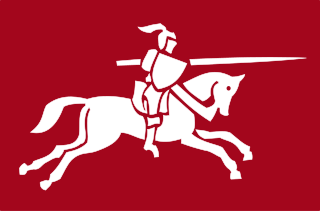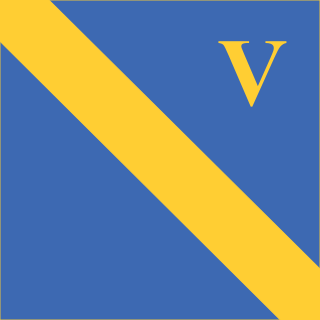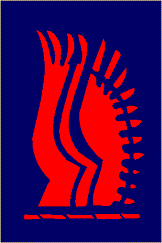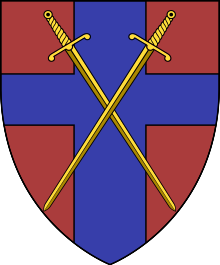
I Corps was an army corps in existence as an active formation in the British Army for most of the 80 years from its creation in the First World War until the end of the Cold War, longer than any other corps. It had a short-lived precursor during the Waterloo Campaign. It served as the operational component of the British Army of the Rhine during the Cold War, and was tasked with defending West Germany.

VIII Corps was a British Army corps formation that existed during the First and Second World Wars. In the latter, it took part in the Normandy Campaign in 1944, where it was involved in Operation Epsom and Operation Goodwood. It would later play a supporting role in Operation Market Garden and finish the war by advancing from the Rhine to the Baltic Sea.

The 3rd Division, also known as The Iron Division, is a regular army division of the British Army. It was created in 1809 by Arthur Wellesley, 1st Duke of Wellington, as part of the Anglo-Portuguese Army, for service in the Peninsular War, and was known as the Fighting 3rd under Sir Thomas Picton during the Napoleonic Wars. The division fought at the Battle of Waterloo, as well as during the Crimean War and the Second Boer War. As a result of bitter fighting in 1916, during the First World War, the division became referred to as the 3rd (Iron) Division, or the Iron Division or Ironsides. During the Second World War, the division fought in the Battle of France including a rearguard action during the Dunkirk Evacuation, and played a prominent role in the D-Day landings of 6 June 1944. The division was to have been part of a proposed Commonwealth Corps, formed for a planned invasion of Japan in 1945–46, and later served in the British Mandate of Palestine. During the Second World War, the insignia became the "pattern of three" — a black triangle trisected by an inverted red triangle.

The 4th Infantry Division was a regular infantry division of the British Army with a very long history, seeing active service in the Peninsular War and Waterloo Campaign, the Crimean and Boer Wars and both World Wars. It was disbanded after the Second World War and reformed in the 1950s as an armoured formation before being disbanded and reformed again and finally disbanded on 1 January 2012.

The 5th Infantry Division was a regular army infantry division of the British Army. It was established by Arthur Wellesley, 1st Duke of Wellington for service in the Peninsular War, as part of the Anglo-Portuguese Army, and was active for most of the period since, including the First World War and the Second World War and was disbanded soon after. The division was reformed in 1995 as an administrative division covering Wales and the English regions of West Midlands, East Midlands and East. Its headquarters were in Shrewsbury. It was disbanded on 1 April 2012.

The 8th Infantry Division was an infantry division of the British Army that was active in both the First and Second World Wars. The division was first formed in October 1914 during the First World War, initially consisting mainly of soldiers of the Regular Army and served on the Western Front throughout the war, sustaining many casualties, before disbandment in 1919. The division was reactivated in Palestine, under the command of Major-General Bernard Montgomery, in the late 1930s in the years running up to the Second World War before being disbanded in late February 1940. It was briefly reformed in Syria in an administrative role during 1942-3.

The 1st Division is an active division of the British Army that has been formed and disestablished numerous times between 1809 and the present. In its original incarnation as the 1st Division, it took part in the Peninsular War—part of the Coalition Wars of the Napoleonic Wars—and was disbanded in 1814 but was re-formed the following year for service in the War of the Seventh Coalition and fought at the Battle of Waterloo. It remained active as part of the British occupation of France until it was disbanded in 1818, when the British military withdrew. The division was then raised as needed; it served in the Crimean War, the Anglo-Zulu War, and the Second Boer War. In 1902, the British Army formed several permanent divisions, which included the 1st Division, which fought in the First World War, made various deployments during the interwar period, and took part in the Second World War when it known as the 1st Infantry Division.

The 1st Canadian Division is a joint operational command and control formation based at CFB Kingston, and falls under Canadian Joint Operations Command. It is a high-readiness unit, able to move on very short notice, and is staffed and equipped to meet Canada’s military objectives to counter any potential threat.

The II Corps was an army corps of the British Army formed in both the First World War and the Second World War. There had also been a short-lived II Corps during the Waterloo Campaign.

The 41st Division was an infantry division of the British Army, raised during the First World War as part of Lord Kitchener's New Armies. The division saw service on the Western Front and later on the Italian Front.
The Light Division is a light infantry division of the British Army. It was reformed in 2022, as part of Future Soldier reforms.

The 15th Infantry Brigade, later 15 Brigade, was an infantry brigade of the British Army. It was part of the regular 5th Infantry Division during the First World War and Second World War, and was subsequently part of the 2nd Infantry Division in the north of the United Kingdom, with specific responsibility for the areas of North East England and Yorkshire and the Humber.

The 24th Infantry Brigade was an infantry brigade of the British Army from the First World War. It was reraised during the Second World War, as the 24th Infantry Brigade (Guards). During various designations, the brigade was active throughout the Cold War and existed until 1999, when it was merged with the 5 Airborne Brigade to become 16 Air Assault Brigade.

The 11th Security Force Assistance Brigade is a brigade of the British Army which is intended to train and assist foreign forces. In 2021, under the Future Army changes, the brigade was redesignated, formerly being the 11th Infantry Brigade & HQ South East. Prior to the Army 2020 changes in 2013, the brigade was temporarily activated for deployment to Afghanistan. Originally formed in the Second Boer War, the brigade was engaged during both World Wars.
The 10th Infantry Brigade was a Regular Army infantry brigade of the British Army formed during the Second Boer War in 5th Division, and during both World Wars the brigade was part of the 4th Infantry Division.

The 6th Infantry Brigade was a regular infantry brigade of the British Army that was in existence during the Second Boer War, the First World War and the Second World War and later formed part of British Army of the Rhine.

HQ Northern Ireland was the formation responsible for the British Army in and around Northern Ireland. It was established in 1922 and disbanded, replaced by a brigade-level Army Reserve formation, 38 (Irish) Brigade, in 2009.
The 33rd Armoured Brigade was an armoured brigade of the British Army that was active in northwestern Europe in the Second World War from June 1944 until May 1945 and from 1980 to 1992.

The Northern Army Group (NORTHAG) was a NATO military formation comprising four Western European Army Corps, during the Cold War as part of NATO's forward defence in the Federal Republic of Germany.
The following is a hierarchical outline for the structure of the British Army in 1989. The most authoritative source for this type of information available is Ministry of Defence, Master Order of Battle, and United Kingdom Land Forces, HQ UKLF, UKLF ORBAT Review Action Plan, HQ UKLF, 1990.





















